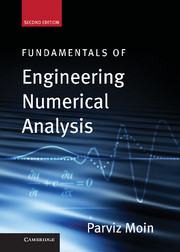Book contents
- Frontmatter
- Contents
- Dedication
- Preface to the Second Edition
- Preface to the First Edition
- 1 INTERPOLATION
- 2 NUMERICAL DIFFERENTIATION – FINITE DIFFERENCES
- 3 NUMERICAL INTEGRATION
- 4 NUMERICAL SOLUTION OF ORDINARY DIFFERENTIAL EQUATIONS
- 5 NUMERICAL SOLUTION OF PARTIAL DIFFERENTIAL EQUATIONS
- 6 DISCRETE TRANSFORM METHODS
- A A REVIEW OF LINEAR ALGEBRA
- Index
Preface to the Second Edition
Published online by Cambridge University Press: 05 June 2012
- Frontmatter
- Contents
- Dedication
- Preface to the Second Edition
- Preface to the First Edition
- 1 INTERPOLATION
- 2 NUMERICAL DIFFERENTIATION – FINITE DIFFERENCES
- 3 NUMERICAL INTEGRATION
- 4 NUMERICAL SOLUTION OF ORDINARY DIFFERENTIAL EQUATIONS
- 5 NUMERICAL SOLUTION OF PARTIAL DIFFERENTIAL EQUATIONS
- 6 DISCRETE TRANSFORM METHODS
- A A REVIEW OF LINEAR ALGEBRA
- Index
Summary
Since the original publication of this book ten years ago, the available computer power has increased by more than 2 orders of magnitude due to massive parallelism of computer processors and heterogeneous computer clusters. Today, scientific computing is playing an ever more prominent role as a tool in scientific discovery and engineering analysis.
In the second edition an introduction to the finite element method has been added. The finite element method is a widely used technique for solving partial differential equations (PDEs) in complex domains. As in the first edition, numerical solution of PDEs is treated in Chapter 5, and the development there is based on finite differences for spatial derivatives. This development is followed in Chapter 6 by an introduction to more advanced transform methods for solving PDEs: spectral methods and, now, the finite element method. These methods are compared to the finite difference methods in several places throughout Chapter 6.
Hopefully, most of the errors that remained in the 2007 reprint of the book have now been corrected. Several exercises have also been added to all the chapters. In addition, complete MATLAB programs used for all the worked examples are available at www.cambridge.org/Moin. Students should find this new feature helpful in attempting the exercises, as similar computer programs are used in many of them. Working out the exercises is critical to learning numerical analysis, especially using this book.
- Type
- Chapter
- Information
- Fundamentals of Engineering Numerical Analysis , pp. ix - xPublisher: Cambridge University PressPrint publication year: 2010



